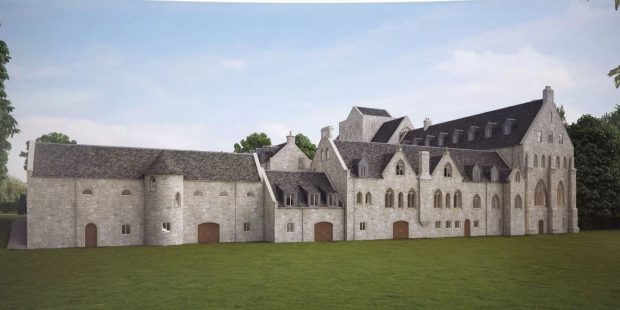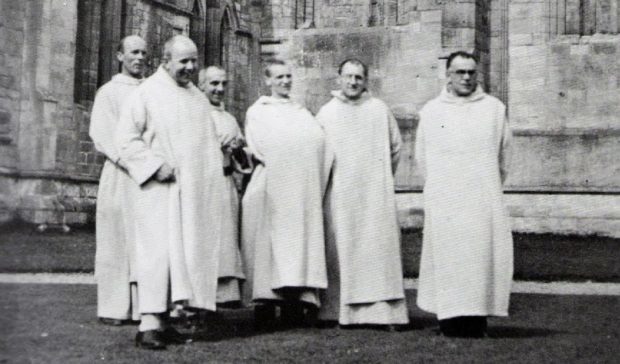For nearly four centuries silence was all that surrounded the remains of one of the north-east’s most picturesque places of worship.
But when the bells chime at Pluscarden Abbey today it will mark seven decades since the monastery was reformed in the countryside on the outskirts of Elgin.
In that time its renown has grown and it is estimated that about 15,000 people a year now visit the Benedictine monk commune for peace and reflection.
Now it is impossible for those who pass through the gates and up the woodland trail among pheasants and partridges not to marvel at the impressive sight of the abbey.
Its Medieval stone walls, which were first built in 1230, do however retain clues to the hardship faced by the five monks, dubbed the Pluscarden Pioneers, who reformed the monastery in 1948.
Dom Brendan McHugh, Dom Ninian Sloane, Dom Maurus Deegan, Brother Andrew Prescott and Brother Cuthbert Swarbrick were hand-picked from the population at Prinknash Abbey in Gloucestershire to lead the way for others due to their joinery and bricklaying skills.
When the hardy group arrived at Pluscarden in April 1948 they were forced to live in tents while repairs were undertaken on the tower, bells were sourced and a roof erected over the building.
Stone had been plundered from the place of worship during the previous centuries, with the last monk having left in 1587 during the Scottish Reformation.
Brother Michael de Klerk, who lives at the abbey today, said: “They were practical men, which is probably the best way to put it.
“Their job was to get the place habitable for others to follow. That happened very soon after.
“There was a target of September 8 given to resume the timetable of monastic life again and they did it.
“I think it was very hard going for them during that first five months. The windows were all gone and they slept on the floor.
“I don’t think it’s that normal for lovely ruins to be restored to the extent that Pluscarden has been but the abbot at Prinknash was a bit of a romantic and I think he was enchanted about taking the whole thing on.”
A huge crowd of people gathered under temporary shelter for a restoration mass at Pluscarden to celebrate its reestablishment.
After a roof was erected at the tower, it took 15 years for the ancient walls to completely dry out and vegetation to stop springing from them after centuries exposed to the elements.
It was not until 1966 though that the then priory gained its independence from Prinknash to allow it to become an abbey in the following years.
Since then restorations have gathered pace, with the choir roof replaced in the 1980s to celebrate 750 years since its formation and the west wing restored during the following decade.
Visitors from across the world now travel to the monastery to visit the home of the 20 monks who attend the daily running of it, amongst eight daily church services and chores.
Today, a celebratory mass, lunch and concert will be held to reflect on seven decades back at the abbey.
Brother Michael added: “We still have people regularly stay with us who are considering joining us. We have some nibblers with us just now.
“There are always about 20 monks here. It’s important to have that number in order to maintain our way of life.”
Focus firmly on Pluscarden’s future during anniversary year
Although Pluscarden’s origins are rooted firmly in the past, its residents have their eyes firmly fixed on the future while growing apples in the grounds and producing honey from bees.
A £1.8 million fundraiser is currently underway to complete the South Range project at the monastery, which will create a new building for female retreats, room for an expanded library and allow for the conversion of an existing building into a heritage centre.
 Most of the money for the latest phase of work is expected to be secured from funding applications.
Most of the money for the latest phase of work is expected to be secured from funding applications.
However, poignant pilgrimages have been organised during the last year to bolster the cause – including recreating the original Pluscarden monks’ journey from Burgundy in France to Moray.
Ancient stones from Val des Choues were taken on the mission to form the foundations of the restoration project.
A series of dinners are also being planned with high-profile guest speakers.
Meanwhile, slates funded by locals sit at the foot of the visitor centre with the names of well-wishers marked upon them, ready to be lifted onto the roof of the new buildings.
David Broadfoot, a former Lieutenant Colonel in the Gordon Highlanders, is spearheading the effort.
He said: “It’s a glorious location. In the early morning there are deer, pheasants, partridges and owls all there. I think it adds to the appeal.
“We’ve had tremendous support from the public so far. It’s a bit of a challenge because we’re asking people to support a building, not a charity that may have a more emotional connection.
“It’s a difficult balancing act too because we want to make sure the abbey has a high profile but at the same time do nothing that threatens the monks’ way of life. It’s important to look after that.
“The monks are fabulous people and it would be a mistake to think they are not aware of modern life. They see the effects of alcohol, drugs and other problems – probably more than most.”
